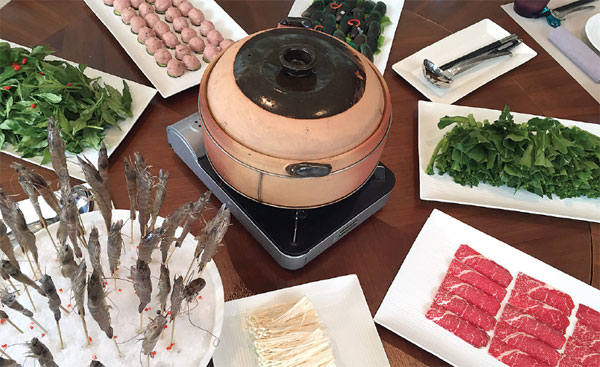Tastes of the sea
|
Danjia hotpot features green-shell mussels, shrimp, meatballs, beef, enoki mushrooms and local vegetables. Photos by Yang Feiyue / China Daily |
Hainan fare makes good use of fish and shellfish, Yang Feiyue finds on a trip to the island.
As visitors flock to Hainan province to seek warmth and clean air as the winter cold envelops much of China, restaurants there dish up local gourmet treats.
The favorite ingredients of the local Danjia people have been introduced to the tables of the Chinese restaurant Five Senses at the Westin Blue Bay Resort & Spa.
Danjia cuisine focuses on bringing out the original taste of fresh seafood and uses very simple seasonings, mostly oil and salt.
"We want guests to enjoy the taste of Danjia cuisine and experience Danjia culture," says Huang Qiyuan, the executive chef of the restaurant. The Danjia people are aboriginal residents mostly living in stilt houses along the coast of the island, as well as Guangdong province and the Guangxi Zhuang autonomous region.
Huang has been a star hotel chef for 16 years. Some of the courses have been adjusted a little to better cater to outsiders' tastes, while some were made by the book for their distinctive characteristics.
"Mixing the Guangdong cooking methods could blunt the edge of some spicy dishes and enrich the taste of some others," Huang says.
The first course, Danjia hotpot, is an eye opener with 24 dipping sauces, from the basic necessities - sesame oil and paste, soy sauce, fresh and spicy red chilies and ground peanuts - to some less-common options, such as a sliced-open small green orange and sauce made of shredded, fried fish.
The course for two costs 298 yuan ($46) and features red-yellow hotpot broth and eight ingredients: green-shell mussels, shrimp, meatballs, beef, enoki mushrooms and local vegetables.
Clams, shrimp and pork are stewed together for three hours over carefully controlled heat to create the well-balanced rich taste and the color of the soup.
Shrimp is added to the traditional recipe to enhance the taste, Huang says.
It's tradition to first sip the broth, which has a silky texture and a bit of seafood sweetness, and then put in the shellfish to enrich the soup for other nibbles to be dipped later.
The deep-sea shrimp has a firm texture and a very pleasant sweetness. It doesn't require the complement of any dipping sauce, which could overwhelm the original taste.
The meatballs are made of fresh pork, hammered by hand, and the addition of winter-mushroom chunks, coriander and dried shrimp give them a great flavor.
Two plates of imported Australian beef, one with lean meat from the thigh and the other interlaced with fat from the back, are sliced with a proper thickness, rather than those cut paper-thin by machines. They were both smooth and chewy and needed only seconds in the boiling soup.
The surprise came from the complimentary seafood congee, with crab chunks steeped in rice that had stewed for hours until it disintegrated. The generous portion of congee absorbed flavors from the crab, and slid down the throat without any chewing.
The congee seems to go best with the marinated salted fish with pork belly and garlic (priced at 168 yuan), the second course offered by the restaurant and one traditionally enjoyed by local fishermen. It uses wind-dried deep-sea eel and five-streaked pork with simple seasonings, mainly soy sauce and salt, to maintain the taste of major ingredients.
The slightly salty fish is well complemented by the relatively light-tasting fried pork.
When the sour pig's knuckle is served, the sheer volume and shape of the course is a jaw-dropping sight. The shape of the pig's knuckle is retained, with the main thick bone pointing straight up. The meat gleams and is dotted with half-chopped marinated eggs.
"It is very nutritious and has been used by women who have just given birth to help them recover strength," Huang says.
The big knuckles are blanched first and then stewed over a low flame with sweetened vinegar, ginger and sugar for 12 hours. They are then cooled overnight before being boiled for another 12 hours for the broth to thicken and the meat to be seasoned.
Thick broth seeps through the skin once the teeth hit the elastic skin. The strong sweetness lays siege to the palate but it's soon infiltrated by a delightful sourness that gradually takes over.
The meat magically stays chewy despite the long stewing, proof of the chef's mastery. The sour and sweet flavors balance the innate greasiness of the knuckle.
The pan-fried mackerel features a crisp golden outer layer and tender meat inside. It's neatly presented on fried shredded potato. The chef is particularly proud of the dish's inconspicuous sauce sprinkled on the fish chunks, with its hint of mustard flavor and consistency of soybeans and chicken soup stewed together.
The restaurant sits near the sea and is only a five-minute drive from hot tourist attractions like Nanwan Monkey Islet and floating fishing houses. Diners can work off their food by taking a walk along the beach or playing with monkeys nearby.
Contact the writer at yangfeiyue@chinadaily.com.cn



















